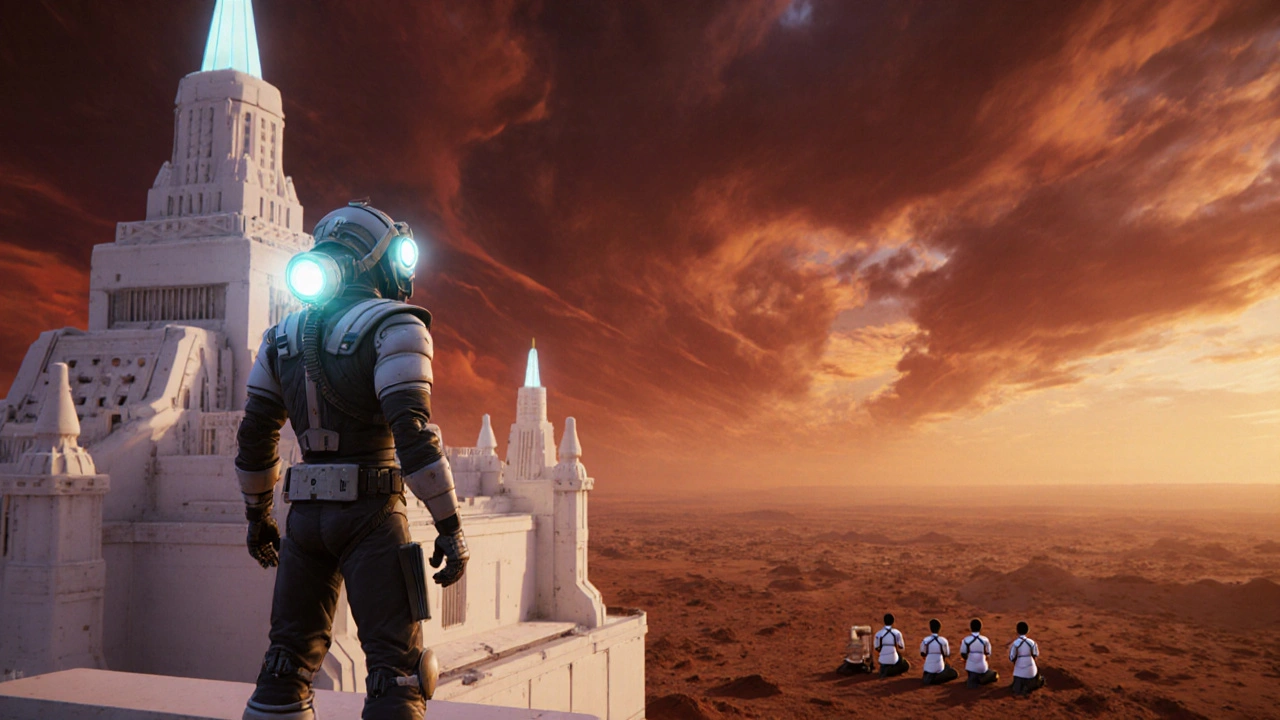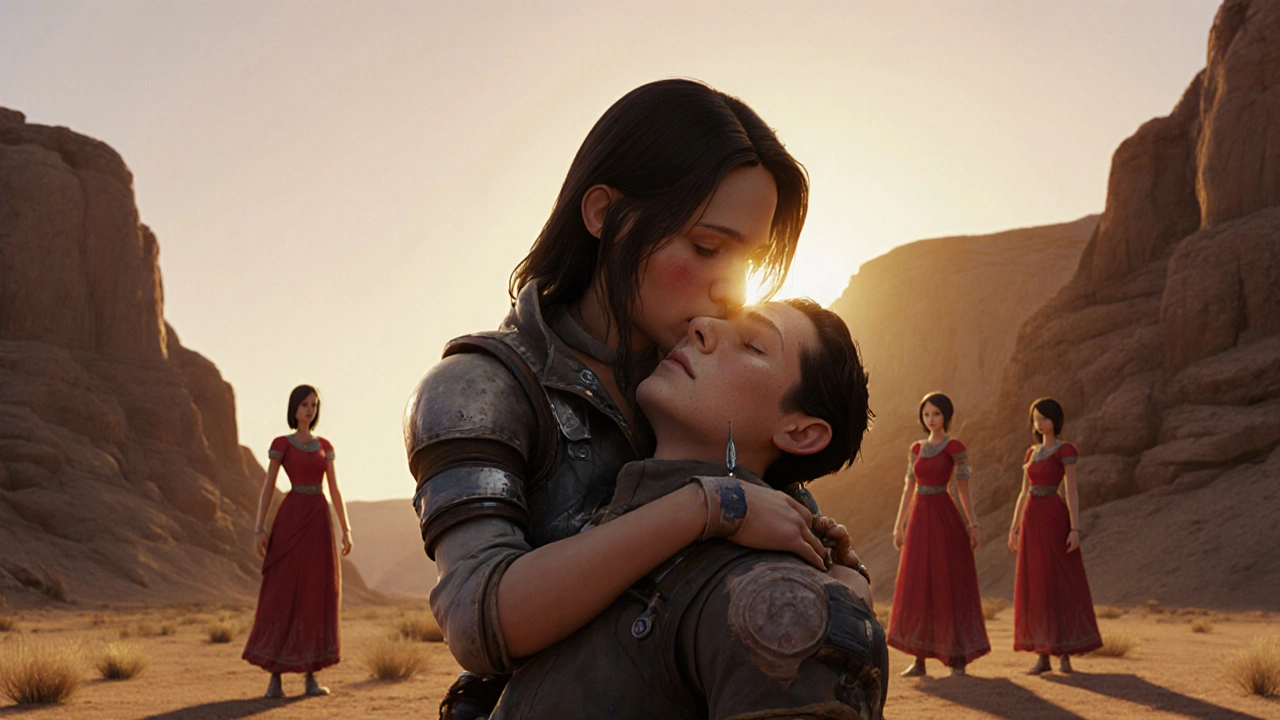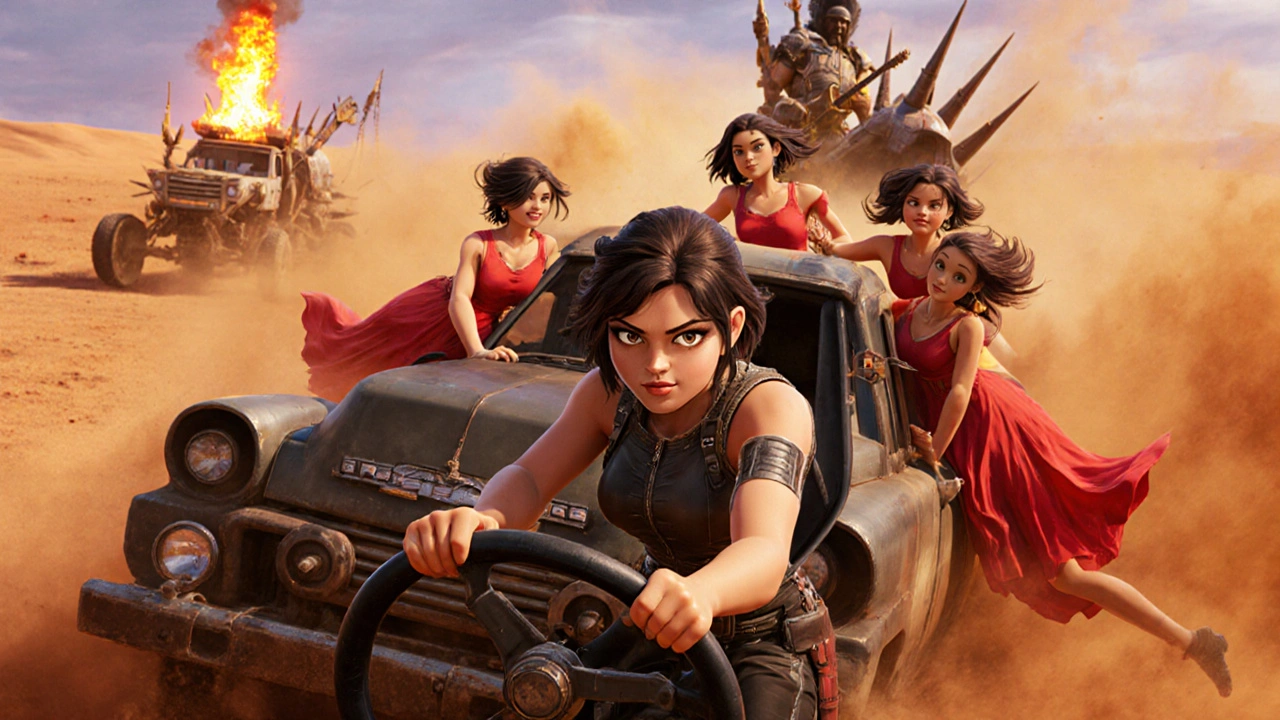Mad Max: Fury Road doesn’t just move-it explodes. No slow builds. No monologues. No CGI armies. Just roaring engines, flying sand, and a woman named Furiosa driving a war rig through hell while being chased by a cult leader in a guitar-shaped car. Released in 2015, it didn’t just revive a 30-year-old franchise-it rewrote the rules of action cinema. And it did it all without saying much at all.
Words Are Optional
Think about the last big action movie you watched. Chances are, it had a hero giving a speech before the final fight. Or a villain monologuing about his plan. Or a sidekick explaining the plot through exposition. Mad Max: Fury Road has none of that.
The entire film is built on action as language. Furiosa’s face tells you everything you need to know about her trauma, her rage, and her determination. Immortan Joe’s breathing apparatus isn’t just a prop-it’s a symbol of his control over life, water, and breath. The War Boys chant their prayers not to make us understand their beliefs, but to show how deeply they’ve been brainwashed. You don’t need subtitles. You don’t need voiceovers. You feel it.
Director George Miller, who first made Mad Max in 1979, said he wanted to make a film that worked like a silent movie. Not because he was nostalgic, but because he knew visuals could carry more weight than dialogue. In one scene, Furiosa spots a green patch of land in the distance. She doesn’t say a word. She doesn’t smile. But her eyes widen. Her jaw tightens. And suddenly, you’re holding your breath with her. That’s visual storytelling at its most powerful.
Practical Chaos, Not Digital Fakes
There are no green screens in Mad Max: Fury Road. No motion-capture suits. No digital explosions. What you see on screen is real. Over 150 vehicles were built by hand. Most were modified from real trucks, cars, and motorcycles. The rigs were driven by stunt drivers on sand dunes in the Namib Desert, where temperatures hit 115°F. One stunt driver lost his thumb in a crash. Another broke his back.
The iconic War Rig-the massive truck Furiosa steals-is 28 feet long, weighs over 10 tons, and was built with real hydraulic lifts to flip and tilt during stunts. The Doof Warrior, the guy playing guitar while on fire, was actually playing a real flame-throwing guitar on a moving vehicle. The pyrotechnics? Real. The flames? Real. The smoke? Real.
This isn’t just about authenticity. It’s about physics. When a car flips, it doesn’t spin like a toy. It tumbles with weight, momentum, and dust. When a wheel explodes, the debris flies in every direction. When the War Rig crashes into a sand dune, the sand doesn’t just disappear-it piles up, rolls, and settles like real earth. That’s why the action feels so terrifyingly real. Your brain doesn’t register it as a movie. It registers it as something happening right in front of you.
Color as Emotion
Most action movies use color to look cool. Mad Max: Fury Road uses color to tell you how the world works.
Immortan Joe’s Citadel is white. Not just clean white-blinding, sterile, holy white. It’s the color of power, control, and false purity. The War Boys wear white armor because they believe they’re dying for a noble cause. But beneath that, the world is dead. The sky is orange-brown. The sand is rust-colored. Everything is dry. Lifeless.
Then there’s Furiosa. She wears a greenish-gray uniform, but her eyes are the only thing that stays vivid. When she escapes, she carries five women with her. They wear bright red dresses. Red isn’t just a color here-it’s rebellion. It’s life. It’s fertility. It’s hope. In a world where water is currency and women are breeding stock, red is the only thing that dares to stand out.
The film’s color palette was designed by production designer Colin Gibson and cinematographer John Seale. They didn’t use filters. They used real paint, real fabrics, and real lighting. The orange sky? That’s the actual desert sky at dawn. The dust clouds? Real wind, real sand, real engines kicking up the earth. Even the blood on the sand looks real because it was made with real, thick, slow-drying syrup mixed with pigment.

The Women Are the Engine
For decades, action movies were about men saving women. Mad Max: Fury Road flips that. The women aren’t damsels. They’re not sidekicks. They’re not even supporting characters. They’re the entire point.
Furiosa isn’t a warrior because she’s strong. She’s a warrior because she’s been broken, used, and forgotten. Her mission isn’t to prove herself-it’s to reclaim what was stolen. The Five Wives aren’t passive victims. They’re survivors. They plan. They fight. They sacrifice. One of them, Cheedo the Fragile, picks up a weapon for the first time and kills a man. She doesn’t scream. She just does it.
Even the final scene isn’t about Max saving Furiosa. It’s about Furiosa saving Max. He’s broken, bleeding, and half-dead. She carries him. She gives him water. She lets him rest. And then, together, they rebuild. The film ends not with a victory parade, but with two people choosing to live-not for glory, not for fame, but because they finally have a choice.
This isn’t just feminist cinema. It’s human cinema. It shows that survival isn’t about who’s strongest. It’s about who’s willing to keep going.
Sound as a Weapon
There’s no score in Mad Max: Fury Road. Not in the traditional sense. Instead, the film uses sound design as rhythm. The engine roars isn’t background noise-it’s the heartbeat of the movie. The clanking of chains. The whirring of the War Rig’s gears. The howl of the wind. These aren’t effects. They’re instruments.
The Doof Warrior’s guitar isn’t just for show. It’s a counterpoint to the chaos. While everything around him is exploding, he plays a single, repeating riff. It’s hypnotic. It makes the violence feel almost ritualistic. The drums? Real. Played by a percussionist on a moving platform. The sound team recorded the actual impact of metal hitting metal, sand hitting glass, and bodies hitting the ground.
When the film goes quiet-like when Furiosa and Max are hiding in the canyon-it’s deafening. You hear every breath. Every rustle of fabric. Every drip of water. That silence isn’t empty. It’s full of tension. It’s the moment before the storm. And when the storm comes, it hits harder because of what came before.

Why It Still Matters
Eight years after its release, Mad Max: Fury Road still stands alone. No other action movie has matched its blend of raw physicality, emotional depth, and visual innovation. Studios still try to copy it. They add more explosions. More CGI. More slow-mo. But they miss the point.
The film works because it trusts the audience. It doesn’t explain. It doesn’t apologize. It just shows you what happened-and lets you feel it. It’s a movie made by people who love cinema, not by committees trying to check boxes.
It’s also a reminder that spectacle doesn’t have to mean emptiness. You can have a movie with no dialogue, no hero’s journey, and no third-act twist-and still leave people changed. Because sometimes, the most powerful stories aren’t told with words. They’re told with wheels, dust, fire, and a woman who refuses to stop driving.
What You Can Learn From It
If you’re a filmmaker, writer, or even just someone who loves stories, here’s what Mad Max: Fury Road teaches you:
- Let visuals carry emotion. A look can say more than a paragraph.
- Real things feel real. Practical effects create emotional weight that CGI can’t replicate.
- Color isn’t decoration-it’s meaning.
- Characters don’t need speeches to be heroic. Action, even quiet action, can define them.
- Silence can be louder than noise.
- Chaos isn’t random. It’s designed. Every crash, every flip, every explosion was planned down to the millisecond.
That’s the secret. The chaos you see on screen? It was controlled. The madness? It was calculated. And that’s what makes it unforgettable.
Why is Mad Max: Fury Road considered a masterpiece of visual storytelling?
It tells a complete, emotionally rich story without relying on dialogue. Emotions, motivations, and world-building are shown through color, movement, sound, and performance. Furiosa’s silence speaks louder than any monologue. The environment itself-dry, broken, violent-tells you the history of this world. Every frame is designed to communicate something, making it a textbook example of show-don’t-tell storytelling.
Did Mad Max: Fury Road use any CGI?
Very little. Over 90% of the film used practical effects. Vehicles were real. Stunts were real. Explosions were real. CGI was only used to remove safety wires, extend backgrounds, or fix minor continuity issues. Even the dust clouds were created with real wind machines and sand. The filmmakers refused to use digital effects unless absolutely necessary, which is why the action feels so tangible.
How did the film’s color palette contribute to its storytelling?
Color was used symbolically. White represented the false purity of Immortan Joe’s regime. Orange and brown showed the dead, dry world. Red, worn by the Five Wives, symbolized life, rebellion, and fertility. The contrast wasn’t just aesthetic-it was narrative. The red dresses stood out like blood in the desert, visually declaring that these women were alive in a world trying to erase them.
Why are the women in Mad Max: Fury Road so important?
They’re not supporting characters-they’re the driving force of the plot. Furiosa leads the mission. The Wives make choices, fight back, and sacrifice themselves. The film rejects the trope of the woman needing rescue. Instead, it shows women as survivors, leaders, and agents of change. Their strength isn’t performative-it’s quiet, stubborn, and deeply human.
Is Mad Max: Fury Road a feminist film?
Yes, but not in the way most people expect. It doesn’t preach. It doesn’t have a speech about equality. Instead, it shows women acting with agency, making hard choices, and surviving in a world designed to control them. The feminism is in the action, not the dialogue. It’s about who gets to drive, who gets to live, and who gets to decide their own fate.
What makes the sound design in Mad Max: Fury Road so effective?
The sound isn’t just loud-it’s rhythmic. Engine roars act as percussion. The Doof Warrior’s guitar creates a haunting counterpoint to the chaos. Silence is used strategically to build tension. Even the wind and sand are part of the score. The sound team recorded real vehicles, real crashes, and real human breaths. This makes the audio feel immersive, not artificial.

